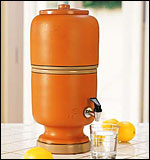Dear Umbra,
I drink a lot of water. I have a food-grade stainless-steel canteen, and I filter my tap water via a Brita. I try to minimize my purchase of plastics, and I try to avoid plastics being anywhere near my food or water. But herein lies my dilemma: I’ve never seen a water filter pitcher that was not plastic. Even if I could find a pitcher, the filters are still plastic. Are there any options short of using a pant leg stuffed with sand and charcoal, as suggested by the U.S. Army’s survival guide? I can’t believe no one has made a charcoal refillable filter.
Kristopher Heinekamp
Belvidere, Ill.
Dearest Kristopher,
The ceramic filter may be for you. I’m sure many of our lovely readers have one, and will write in with comments about the efficacy, longevity, and conversation-pieciness of the ceramic filter and its housing. Additionally, it appears that enterprising persons can learn to make these filters themselves, as have many persons in areas with poor drinking water.

What a crock.
Photo: gaiam.com
The first ceramic water-filtration system I saw was an intriguing and attractive tall crock at a household where rainwater is used for drinking. The filter “candles” or “cartridges” that go in the crock are made from ceramic mixed with various magical stuff such as silver, for sterility, or carbon, for chlorine removal. The housing has two sections. The candles are mounted in the upper compartment, and water must pass through their amazingly complex pores before admittance to the lower chamber. Tap water is poured into the top and filtered down to the bottom container, where a spigot releases water to your every whim. Very few pathogens are admitted to the lower chamber — below .01 percent, apparently. The candles last about six months or more, can be cleaned, and you are Umbra-approved to attempt to compost them. They are, after all, made from clay.

Filters at work in southeast Asia.
Photo: ttocirrod-foundation.org
I found the complex pores and such touted on an industry site, but ceramic filters have a long history outside of industry — and a proven record of triumphing over water-borne pathogens. In areas where drinking water is either always or temporarily undrinkable, money and infrastructure are wanting, and a potter is handy, ceramic filters are doing a heck of a lot of good. They can replace chlorine tablets and boiling, both of which have their own effectiveness problems. If you wish to make your own ceramic filter, out of inspiration or need, the system will look a little different from the one I described above. The potter creates what looks like a large, flat-bottomed bowl or flowerpot, using ceramics mixed with sundry porosity-enhancing additions such as sawdust. The bowl nests inside another container. Contaminated water goes into the bowl and filters out the bottom into the larger container. Voila — clean water. This ceramic filtration system, standardized for easy production by Potters for Peace (!), is used in 14 countries. Details on the system, and something like instructions, can be found at the United Nations’ IDEASS site.
I don’t know why you have been filtering your water, but if ceramic is good enough to defeat deadly diarrhea in Nicaragua, it’s good enough for Belvidere, Ill.
Candley,
Umbra


